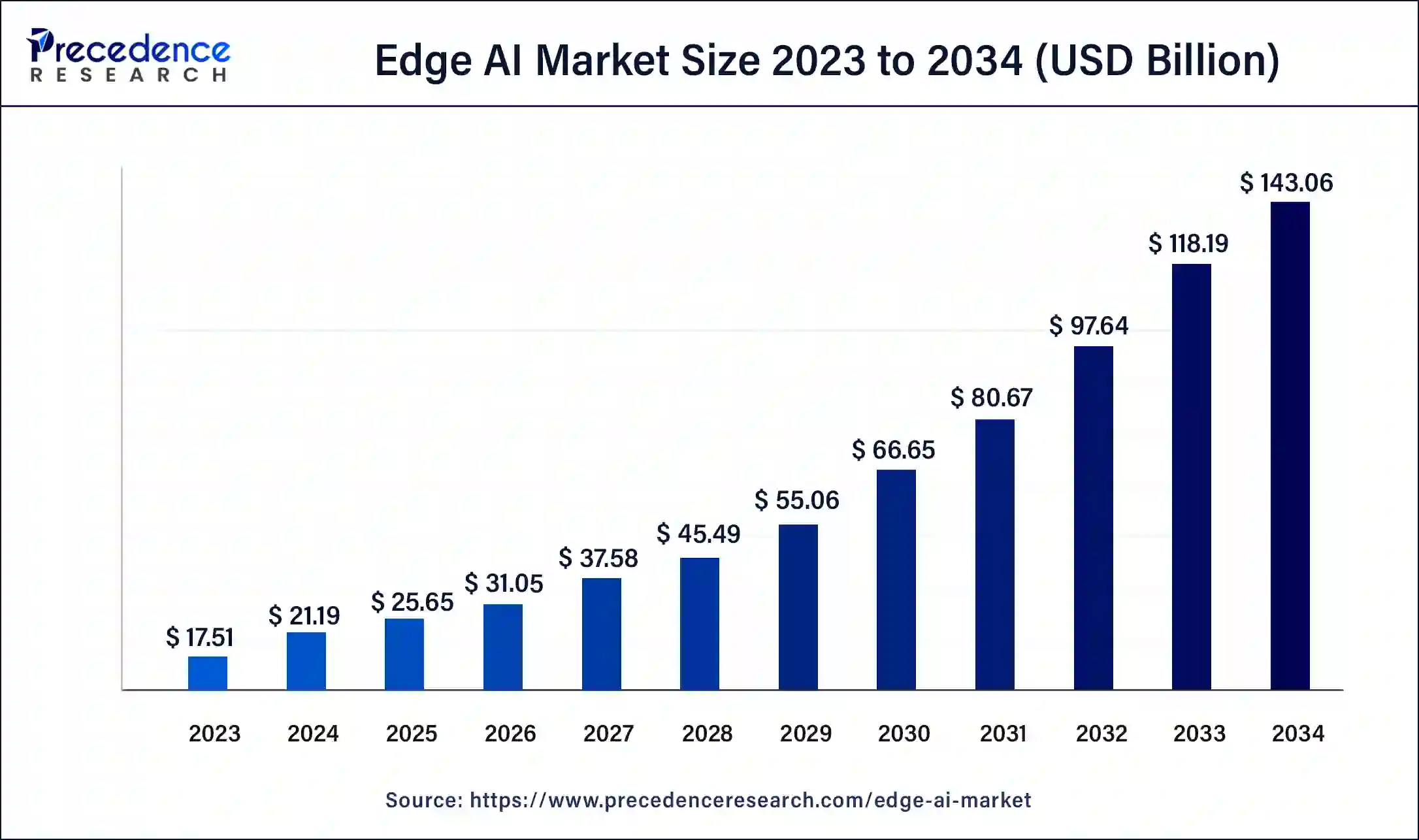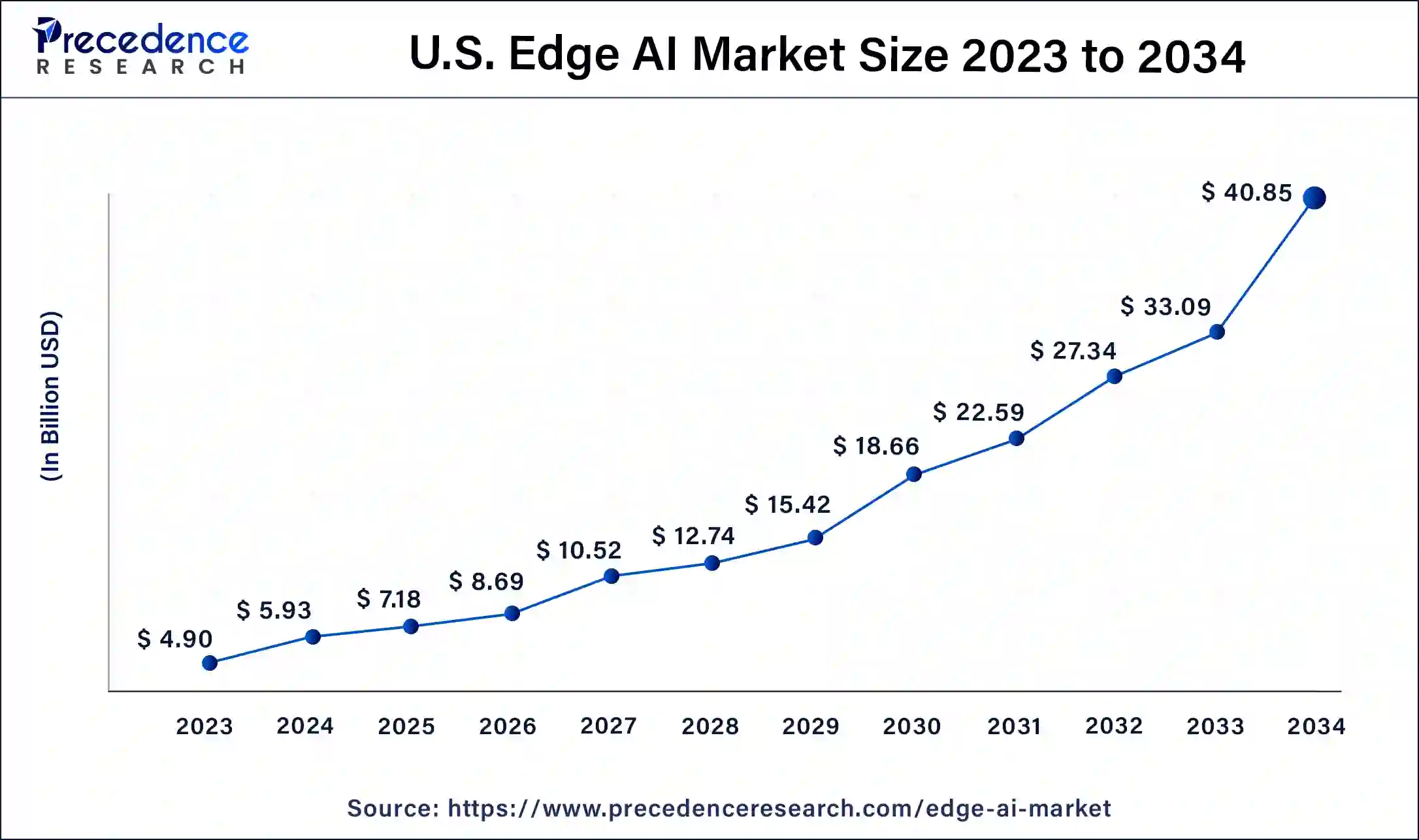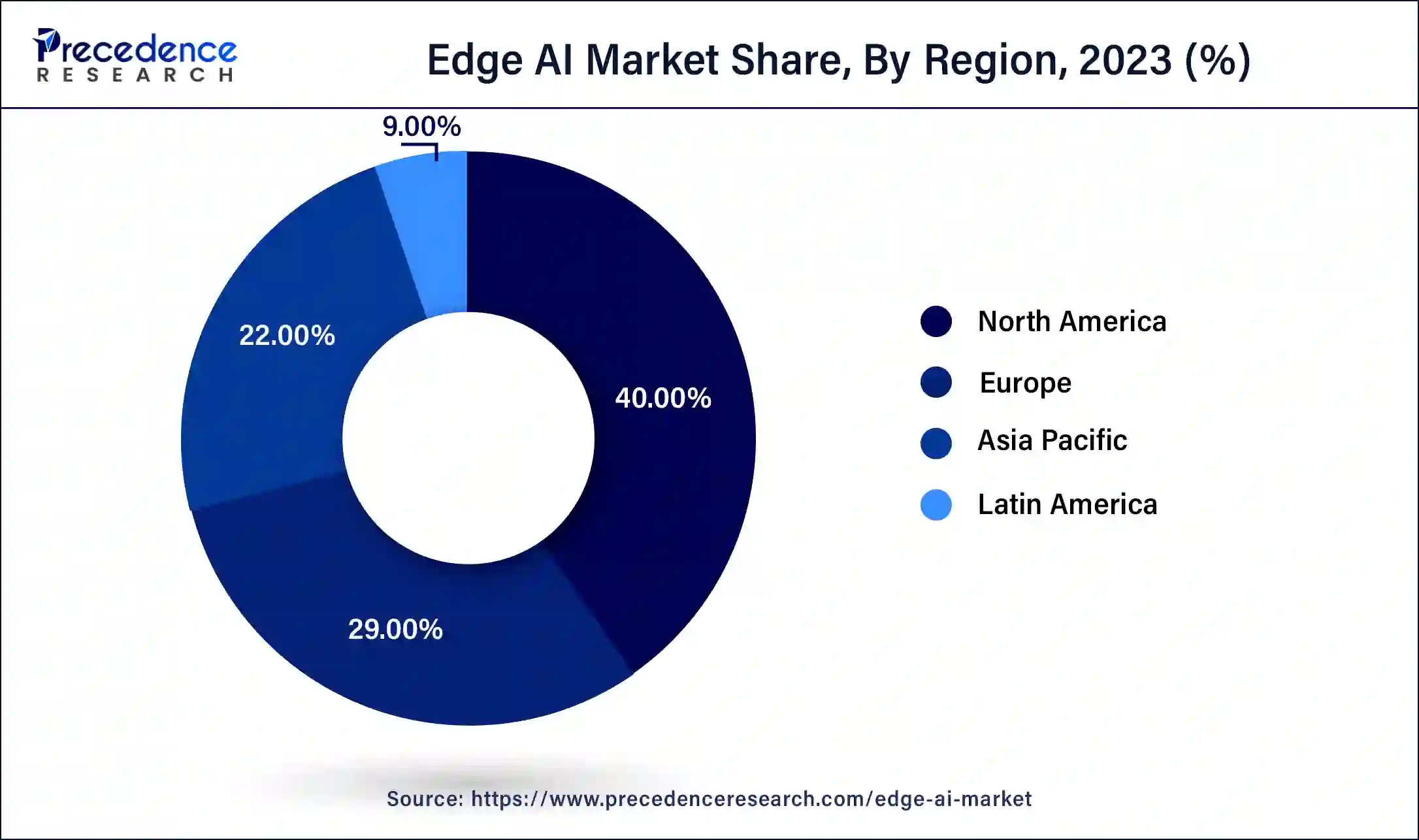August 2024
The global edge AI market size was USD 17.51 billion in 2023, calculated at USD 21.19 billion in 2024 and is expected to be worth around USD 143.06 billion by 2034. The market is slated to expand at 21.04% CAGR from 2024 to 2034.
The global edge AI market size is worth around USD 21.19 billion in 2024 and is anticipated to reach around USD 143.06 billion by 2034, growing at a solid CAGR of 21.04% over the forecast period 2024 to 2034. The North America edge AI market size reached USD 7 billion in 2023. The edge AI market growth is attributed to the increasing demand for real-time data processing and the rapid advancements in edge computing technologies.

The U.S. edge AI market size was exhibited at USD 4.90 billion in 2023 and is projected to be worth around USD 45.85 billion by 2034, poised to grow at a CAGR of 21.26% from 2024 to 2034.

North America dominated the global edge AI market in 2023 due to its advanced technological infrastructure, substantial investments in innovation, and the presence of major technology firms. The United States has led the adoption of edge AI technologies across various sectors, including smart cities, healthcare, and manufacturing. Additionally, edge AI is being deployed more in data centers and cloud services.

Asia Pacific is projected to host the fastest-growing edge AI market in the coming years, owing to rapid urbanization, significant investments in smart technologies, and advancements in digital infrastructure. The region’s growing focus on 5G deployment is anticipated to enhance the capabilities and adoption of edge AI solutions. Additionally, there is an expansion of edge computing applications in consumer electronics and manufacturing.
The accelerating adoption of 5G technology is significantly driving the growth of the edge AI market. Edge AI, which involves processing data locally at the edge of a network rather than in a centralized data center, allows for real-time data analytics and decision-making with minimal latency. This technology is crucial for applications such as smart cities, autonomous vehicles, and industrial automation, where immediate data processing is required.
Additionally, the International Telecommunication Union (ITU) highlights that 5G technology enhances the performance of edge AI solutions, supporting innovations across various sectors, including healthcare and manufacturing.
| Report Coverage | Details |
| Market Size by 2034 | USD 143.06 Billion |
| Market Size in 2023 | USD 17.51 Billion |
| Market Size in 2024 | USD 21.19 Billion |
| Market Growth Rate from 2024 to 2034 | CAGR of 21.04% |
| Largest Market | North America |
| Base Year | 2023 |
| Forecast Period | 2024 to 2034 |
| Segments Covered | Component, End-user, and Regions |
| Regions Covered | North America, Europe, Asia-Pacific, Latin America and Middle East & Africa |
Driver
Surging demand for low-latency processing
Increasing demand for low-latency processing is anticipated to drive the demand for the edge AI market, especially in industries such as autonomous vehicles, robotics, and smart cities. This real-time data processing is vital in areas where a decision has to be made on a real, real-time basis. Current tech goliaths and automotive giants, including Intel and Nvidia, are also designing edge AI hardware and software platforms to optimize real-time choices required for automobiles, and smart city solutions are applying edge computing for far adaptive traffic control and infrastructure monitoring.
The IDC estimated that edge computing is going to grow its spending in the international market and is expected to reach USD 6 billion by 2024 due to the requirement for latency-sensitive computations across automotive and smart infrastructure sectors.
Restraint
High initial costs of deployment
The high initial costs associated with deploying edge AI infrastructure are expected to impede the edge AI market growth. These costs are rather high for the SMEs, as they not be able enough to purchase the required equipment, application, and network. The implementation of edge AI systems also has operational costs, which are related to maintaining and upgrading the systems due to advancements in technologies.
Integrating such state-of-the-art systems requires capital and makes small business in developing economies usually struggle to acquire finances to install such systems. Moreover, high energy consumption by intelligence devices and the need to cool them increases operation costs, especially in regions with expensive power. This has made organizations adopt the edge AI market slowly due to high costs.
Increasing use of edge AI in smart cities
The development of smart cities is expected to create immense opportunities for the players competing in the edge AI market. The rise of smart cities is leading to greater utilization of Edge AI for efficiently managing urban infrastructure and services. Surveillance cameras and smart grid operations AI technologies are used to enhance the use of resources for safety issues.
Edge AI improves the smart city response time and powers real-time analysis, thereby improving the cities' sustainability and efficiency. The application of the edge AI market helps to make improvements in public services such as tracking and maintenance of vehicles to foster better commuters and lower costs. Additionally, the edge AI enables cities to optimize environmental monitoring so the signs of pollution and climate change can be countered in time.
| Applicatio | Impact | Source |
| Traffic Management Transportation | 30% reduction in traffic delays | U.S. Department of Transportation |
| Smart Grid Energy Management Agency | 25% reduction in energy losses | International Energy Agency |
| Emergency Response | Up to 40% faster response times | European Commission |
| Environmental Monitoring Organization | 20% improvement in air quality management | World Health Organization |
The software segment held a significant presence in the edge AI market in 2023 due to the increasing demand for sophisticated data processing and artificial intelligence on different applications, such as smart cities and Industries. The U. S. National Institute of Standards and Technology (NIST) identifies the sophistication of the AI software in improving the operational and decision-making capabilities at the edge. This highlights the implementation of sound edge computing as dependent on the development of software. Furthermore, advanced-edge AI software technology is highly utilized for the processing and analysis of data.
The edge cloud infrastructure segment is expected to grow rapidly in the edge AI market during the forecast period of 2024 to 2034, owing to the increasing need for superior computing capacity and low latency applications. Furthermore, the progression of network technologies has put a significant emphasis on the growth of this segment for future technological enhancements as the deployment of distributed cloud solutions.
The smart cities segment accounted for a considerable share of the edge AI market in 2023. This sector has incorporated edge AI technologies to improve the control of urban conurbations and optimize infrastructure capacity. Technologies of smart cities apply edge AI in traffic systems, security systems, energy systems, and environmental systems. The rise of smart sensors and integrated, real-time analytics is aimed at enhancing the efficiency of resources and improving standards of living in urban environments. Furthermore, smart cities are propelling the edge AI market as an increasing trend toward sustainable urban growth and optimal resource utilization.
The automotive segment is anticipated to grow with a significant CAGR in the edge AI market during the studied years, owing to the rising utilization of advanced-edge AI technology for ADAS, autonomous cars, and connected automobiles. Vehicle edge AI is important, as it helps process data captured from the vehicle’s sensors and cameras, which improves the safety and efficiency of vehicle operations. According to the U. S. Department of Transportation, the incorporation of Edge AI in automotive applications is expected to improve car safety and foster data-driven autopilot vehicles. Furthermore, the rising trend in the investment of the automotive industry in edge AI to enhance safety and connectivity requirements further boosts the market.
Segments Covered in the Report
By Component
By End-user Industry
By Geography
For inquiries regarding discounts, bulk purchases, or customization requests, please contact us at sales@precedenceresearch.com
No cookie-cutter, only authentic analysis – take the 1st step to become a Precedence Research client
August 2024
September 2024
March 2025
April 2025